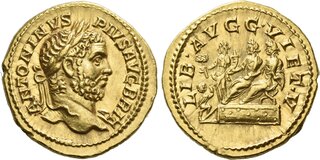| Numismatica Ars Classica > Auction 146 | Auction date: 8 May 2024 |
| Lot number: 2366 Price realized: This lot is for sale in an upcoming auction - Bid on this lot  | Show similar lots on CoinArchives Find similar lots in upcoming auctions on |
| Lot description: Caracalla augustus, 198 – 217. Aureus 211, AV 20 mm, 7.37g. ANTONINVS PIVS AVG BRIT Laureate bust r. , wearing aegis. Rev. LIB AVGG VI ET V Geta and Caracalla, laureate and togate, seated l. on curule chairs set on low daïs, each extending r. hand to small figure climbing stairs holding out fold of toga to receive tessera; Liberalitas standing l., holding abacus in r. hand and cornucopiae in l. hand at fore-edge of daïs. C 130 var. (without PIVS). BMC pg. 371* note. RIC 215b. Calicó 2690 (these dies). Very rare and in exceptional condition for the issue, possibly the finest specimen known. A bold portrait of excellent style and a very detailed reverse type. Virtually as struck and almost Fdc Ex NGSA 4, 2006, 206 and NGSA 5, 2008, 268 sales. The reasons for Caracalla's military expedition to Upper Germany in 213 will probably never be known, for there is no evidence of destruction of Roman cities or fortresses in the region at that time. Perhaps it was a pre-emptive strike to head off trouble that was expected, or it was an exercise to prepare the legions that would lead the imminent campaign against the Parthians. Limited military encounters seem to have occurred in August and September of 213, for on October 6, in Rome, the Arval Brothers made sacrifices "for the safety and German victory of the emperor." Caracalla earned the title Germanicus maximus, and whatever measures he had taken were effective, for peace reigned on the German front for the next two decades. This aureus, with its platform scene, records the emperor's ninth largess, distributed in 214 for that victory. Dio indicates that the campaign was waged against the Alamanni, a confederation of Germanic tribes which had adopted the non-ethnic name ("all men"). This may be questioned because that portion of his work survives only as an epitome. The original name may have been exchanged for one more familiar to a contemporary audience. Caracalla did not assume the title Alamannicus, but Germanicus, and the first properly attested use of Alamanni does not occur until a panegyric of 289 in which the emperor Maximian is lauded for a victory over the Burgundiones et Alamanni. Even if the battles were few, the preparations and related activities were many. Not since the reign of Domitian had so large a Roman army gathered between the Rhine and Danube. The campaign was conducted from Raetia and Mainz, which apparently was the main base of operations. Commemorative inscriptions show there was much road repair and building activity in the region and it seems that the limes were improved, with the palisade being backed up with a bank and ditch. In some areas, stone walls were built like the ones that already existed along the Raetian limes, and inscriptions at some forts in Raetia show that Caracalla visited after the campaign. While in the region, Caracalla is said to have visited the temple of Apollo Grannus at Aquae Granni (Aachen) to seek a cure for his chronic illness. Some authorities suggest that the limited scale of the German campaign and the subsidies offered to the tribes afterward were a consequence of the emperor's health concerns. Soon afterward, on his trek through Asia Minor, Caracalla would invest much hope in the healing powers of the priests of the temple of Aesculapius in Pergamum Estimate: 35000 CHF |  |



